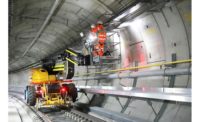London’s troubled Crossrail project has fallen further behind because of COVID-19, which has contributed to another delay and pushed its cost over $24 billion, according to according to owner Crossrail Ltd. (CRL).
The project’s December 2019 completion target was pushed back late last year to summer 2021. That deadline has now slipped again, to the first half of 2022. At the same time, CRL forecasts an additional funding requirement of $1.4 billion in addition to the $2.8 billion increase it secured in December 2018.
Sponsored jointly by Transport for London and the Department for Transport Crossrail’s “Elizabeth line” will link upgraded networks on either side of the city with 21 km of new twin tunnels through the city center.
“Delivery of the Elizabeth line is now in its complex final stages and is being completed at a time of great uncertainty due to the risk and potential impacts of further COVID outbreaks,” says Crossrail’s CEO Mark Wild.
CRL attributes the latest delays to lower than planned productivity on work in shafts, portals and the 10 central section stations, exacerbated by workforce constraints caused by the pandemic.
“Londoners will accept that COVID-19 has played a significant role in this delay, and that the complexity of this project and the need to complete the work safely have meant it’s had to be pushed back yet again,” says Alison Moore, London Assembly Member and chair of the London Assembly Transport Committee. “Lessons must be learned from the way Crossrail officials originally planned for this major infrastructure project.”
Crossrail’s budget was set at $20.8 billion when the government approved construction in 2007. A period of value engineering in 2010 reduced that figure to $19.4 billion, partly by pushing back the completion target from May 2018 to December 2019. The budget went up to $23.1 billion in 2018.





Post a comment to this article
Report Abusive Comment